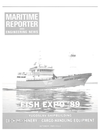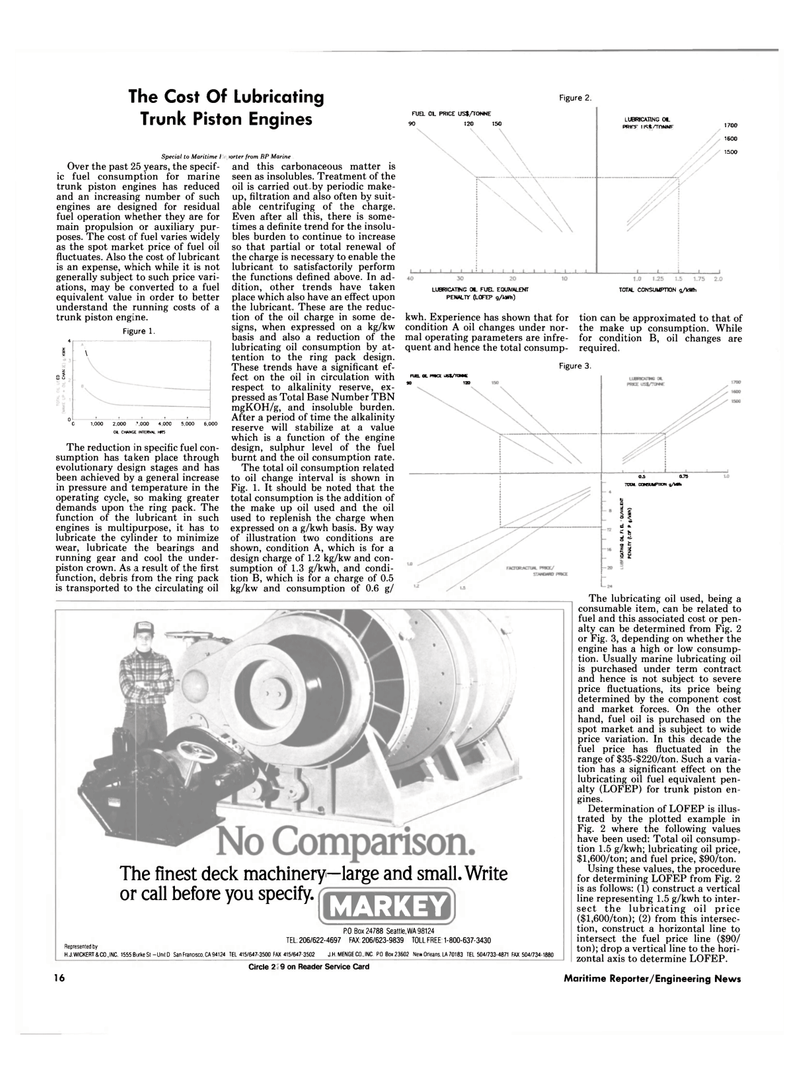
Page 14: of Maritime Reporter Magazine (October 1989)
Read this page in Pdf, Flash or Html5 edition of October 1989 Maritime Reporter Magazine
The finest deck machinery—large and small. Write or call before you specify. MARKEY
RO. Box 24788 Seattle,WA 98124
TEL: 206/622-4697 FAX: 206/623-9839 TOLL FREE: 1-800-637-3430
Represented by:
H.J. WICKERT & CO.,INC. 1555 Burke St-Unit D San Francisco. CA 94124 TEL 415/647-3500 FAX 415/647-3502 J.H. MENGE CO., INC. PO. Box 23602 New Orleans, LA 70183 TEL 504/733-4871 FAX: 504/734-1880
The Cost Of Lubricating
Trunk Piston Engines
Special to Maritime I
Over the past 25 years, the specif- ic fuel consumption for marine trunk piston engines has reduced and an increasing number of such engines are designed for residual fuel operation whether they are for main propulsion or auxiliary pur- poses. The cost of fuel varies widely as the spot market price of fuel oil fluctuates. Also the cost of lubricant is an expense, which while it is not generally subject to such price vari- ations, may be converted to a fuel equivalent value in order to better understand the running costs of a trunk piston engine.
Figure 1. 4 1 \ s I oL- 1 1 L 1 1
C 1.000 2.000 '.000 4.000 5.000 6.000
Ol CHANGE INTERVAL HRS
The reduction in specific fuel con- sumption has taken place through evolutionary design stages and has been achieved by a general increase in pressure and temperature in the operating cycle, so making greater demands upon the ring pack. The function of the lubricant in such engines is multipurpose, it has to lubricate the cylinder to minimize wear, lubricate the bearings and running gear and cool the under- piston crown. As a result of the first function, debris from the ring pack is transported to the circulating oil iorter from BP Marine and this carbonaceous matter is seen as insolubles. Treatment of the oil is carried out.by periodic make- up, filtration and also often by suit- able centrifuging of the charge.
Even after all this, there is some- times a definite trend for the insolu- bles burden to continue to increase so that partial or total renewal of the charge is necessary to enable the lubricant to satisfactorily perform the functions defined above. In ad- dition, other trends have taken place which also have an effect upon the lubricant. These are the reduc- tion of the oil charge in some de- signs, when expressed on a kg/kw basis and also a reduction of the lubricating oil consumption by at- tention to the ring pack design.
These trends have a significant ef- fect on the oil in circulation with respect to alkalinity reserve, ex- pressed as Total Base Number TBN mgKOH/g, and insoluble burden.
After a period of time the alkalinity reserve will stabilize at a value which is a function of the engine design, sulphur level of the fuel burnt and the oil consumption rate.
The total oil consumption related to oil change interval is shown in
Fig. 1. It should be noted that the total consumption is the addition of the make up oil used and the oil used to replenish the charge when expressed on a g/kwh basis. By way of illustration two conditions are shown, condition A, which is for a design charge of 1.2 kg/kw and con- sumption of 1.3 g/kwh, and condi- tion B, which is for a charge of 0.5 kg/kw and consumption of 0.6 g/
Circle 209 on Reader Service Card 16
Figure 2. 1600 1500
LUBRICATING OL FUEL EQUVALENT
PEtW.Tr (LOFEP g/kWh) kwh. Experience has shown that for condition A oil changes under nor- mal operating parameters are infre- quent and hence the total consump-
TOTAL CONSUMPTION g/kWh tion can be approximated to that of the make up consumption. While for condition B, oil changes are required. 0.5 075
TUN CONSmFTON 3/k»i
S ii o < d ^ = fc * i M 3 a
FUEL OL PRICE USt/TONNE 90 120 150 na 0t PWCE UES/TOMC 90 120
Figure 3.
The lubricating oil used, being a consumable item, can be related to fuel and this associated cost or pen- alty can be determined from Fig. 2 or Fig. 3, depending on whether the engine has a high or low consump- tion. Usually marine lubricating oil is purchased under term contract and hence is not subject to severe price fluctuations, its price being determined by the component cost and market forces. On the other hand, fuel oil is purchased on the spot market and is subject to wide price variation. In this decade the fuel price has fluctuated in the range of $35-$220/ton. Such a varia- tion has a significant effect on the lubricating oil fuel equivalent pen- alty (LOFEP) for trunk piston en- gines.
Determination of LOFEP is illus- trated by the plotted example in
Fig. 2 where the following values have been used: Total oil consump- tion 1.5 g/kwh; lubricating oil price, $l,600/ton; and fuel price, $90/ton.
Using these values, the procedure for determining LOFEP from Fig. 2 is as follows: (1) construct a vertical line representing 1.5 g/kwh to inter- sect the lubricating oil price ($l,600/ton); (2) from this intersec- tion, construct a horizontal line to intersect the fuel price line ($90/ ton); drop a vertical line to the hori- zontal axis to determine LOFEP.
Maritime Reporter/Engineering News
LUBRICATING OL
PRITF ll^t^TONNT 1700

 13
13

 15
15
